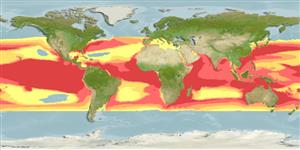分類 / Names
共通名の | 類義語 | Catalog of Fishes(部類, 種) | ITIS | CoL | WoRMS | Cloffa
板鰓亜鋼(サメとエイ類) (sharks and rays) >
Carcharhiniformes (Ground sharks) >
Carcharhinidae (Requiem sharks)
Etymology: Carcharhinus: karcharos (Gr.), sharp or jagged; rhinus, an ancient name for sharks, from rhine (Gr.), rasp, both words alluding to a shark's jagged, rasp-like skin. (See ETYFish); longimanus: longus (L.), long; manus (L.) hand, referring to its long paddle-like pectoral fins. (See ETYFish).
More on author: Poey.
Environment: milieu / climate zone / depth range / distribution range
生態学
海; 海洋回遊性 (Ref. 51243); 深さの範囲 0 - 1082 m (Ref. 106604), usually 0 - 152 m (Ref. 55185). Subtropical; 18°C - 28°C (Ref. 244); 46°N - 43°S, 180°W - 180°E (Ref. 6871)
Circumglobal in tropical and warm-temperate waters Ref. 244). Highly migratory species.
Length at first maturity / サイズ / 重さ / 年齢
Maturity: Lm 195.7, range 180 - 226 cm
Max length : 400 cm TL オス/雌雄の選別がない; (Ref. 89972); common length : 270 cm TL オス/雌雄の選別がない; (Ref. 9253); 最大公表体重: 167.4 kg (Ref. 40637); 最大記録サイズ: 22 年 (Ref. 31395)
背面の脊椎 (合計): 0; 背鰭 (合計): 0; 肛門の骨 0; 臀鰭: 0. A stocky shark with a huge, rounded 1st dorsal fin, and long, wide-tipped pectoral fins; snout bluntly rounded; upper teeth triangular; interdorsal ridge present (Ref. 5578). Back usually dark grey with a bronze tinge, sometimes brown or bluish; belly whitish, sometimes with a yellow tinge; tips off first dorsal, pectorals, and lower lobe of caudal often white or with white spots (sometimes absent); ventral surface of pelvic fins, apices of anal and second dorsal, and ventral lobe of caudal often with black spots; black or dusky saddle-marks in front of second dorsal, upper margin of caudal and between dorsal fins (especially in young) (Ref. 9997).
An oceanic deep-water species which sometimes comes close to shore (Ref. 244). Found surface to depths of at least 150 m (Ref. 26938). Epipelagic usually over water depths of >184 meters (Ref. 58302). Frequently accompanied by Remora, Coryphaena, pilot fishes (Ref. 30573), and tortoises. Feeds oceanic bony fishes, also threadfins, stingrays, sea turtles, sea birds, gastropods, squid, crustaceans, mammalian carrion and garbage (Ref. 5578), including tuna and mahimahi (Ref. 1602, 37816). Viviparous (Ref. 50449). There is pronounced partial segregation by size and sex in some areas. This is an active, almost fearless shark also charged in human attacks (Ref. 244). Probably responsible for many open-ocean attacks after air or sea disasters (Ref. 6871). Utilized fresh, frozen (Ref. 9987), smoked, and dried-salted for human consumption; hides for leather, fins for fin soup, liver oil for vitamins, also processed into fishmeal (Ref. 244). 1 to 15 young, 60 to 65 cm, are born per litter (Ref. 1602).
Life cycle and mating behavior
成熟 | 繁殖 | 放精 | 卵 | 生産力 | 幼生
Viviparous, placental (Ref. 50449). Litter size 1-15 pups; 60-65 cm at birth (Ref. 244). Distinct pairing with embrace (Ref. 205).
Compagno, L.J.V., 1984. FAO Species Catalogue. Vol. 4. Sharks of the world. An annotated and illustrated catalogue of shark species known to date. Part 2 - Carcharhiniformes. FAO Fish. Synop. 125(4/2):251-655. Rome: FAO. (Ref. 244)
Human uses
水産業: 商業; ゲームフィッシュ: はい
より多くの情報
参考文献水産養殖水産養殖の紹介緊張遺伝子のElectrophoreses遺伝病気行列NutrientsMass conversion
用具
特記事項
XMLをダウンロードして下さい
インターネットの情報源
Estimates based on models
Preferred temperature (Ref.
123201): 17.9 - 28.9, mean 26.8 °C (based on 6810 cells).
Phylogenetic diversity index (Ref.
82804): PD
50 = 0.5000 [Uniqueness, from 0.5 = low to 2.0 = high].
Bayesian length-weight: a=0.01023 (0.00631 - 0.01659), b=3.06 (2.93 - 3.19), in cm total length, based on LWR estimates for this species & Genus-body shape (Ref.
93245).
栄養段階 (Ref.
69278): 4.2 ±0.4 se; based on diet studies.
回復力 (Ref.
120179): 非常に低い, 14年以上の倍増期間の最小個体群 (K=0.1; tm=7; tmax=22; Fec=1).
Prior r = 0.06, 95% CL = 0.04 - 0.10, Based on 2 stock assessments.
Fishing Vulnerability (Ref.
59153): Very high vulnerability (84 of 100).
Climate Vulnerability (Ref.
125649): Very high vulnerability (76 of 100).
Nutrients (Ref.
124155): Calcium = 7.66 [1.45, 44.26] mg/100g; Iron = 0.723 [0.193, 2.260] mg/100g; Protein = 22.4 [19.6, 24.6] %; Omega3 = 0.259 [0.106, 0.652] g/100g; Selenium = 26 [8, 75] μg/100g; VitaminA = 6.58 [2.21, 19.27] μg/100g; Zinc = 0.355 [0.172, 0.669] mg/100g (wet weight);
